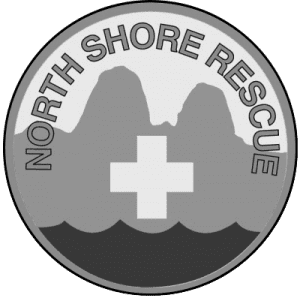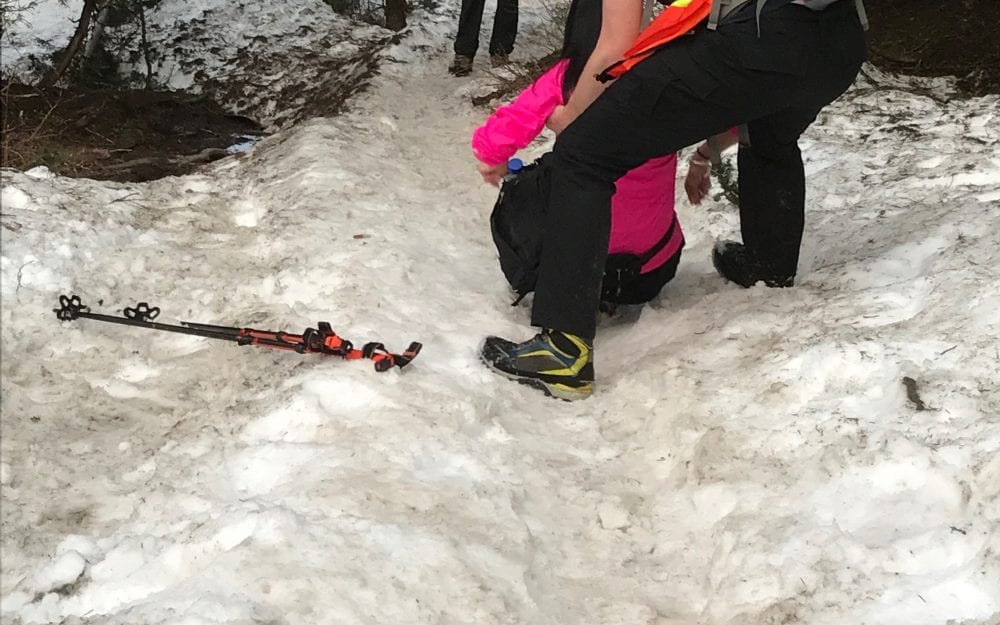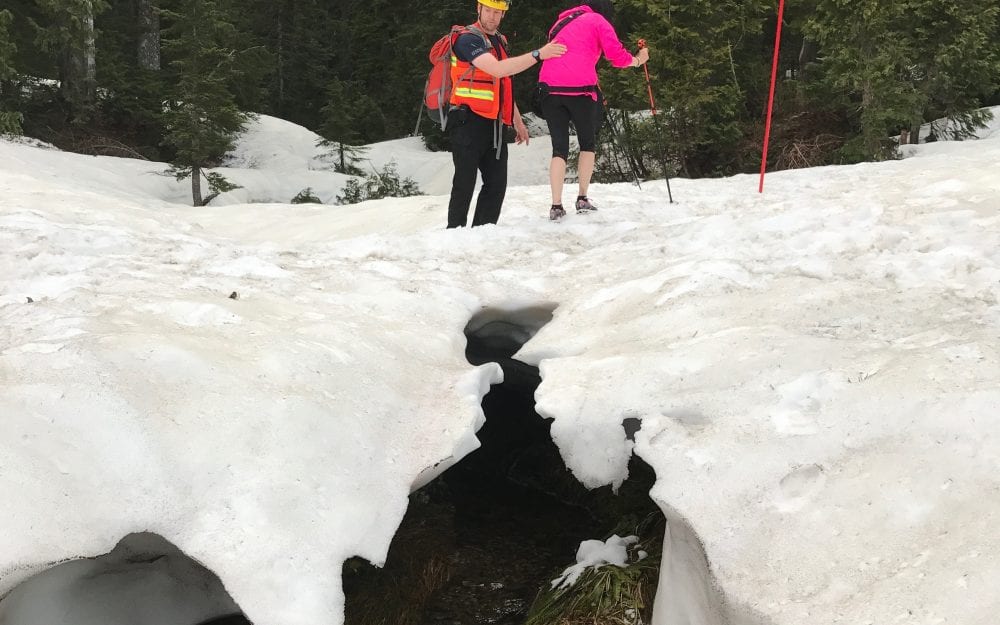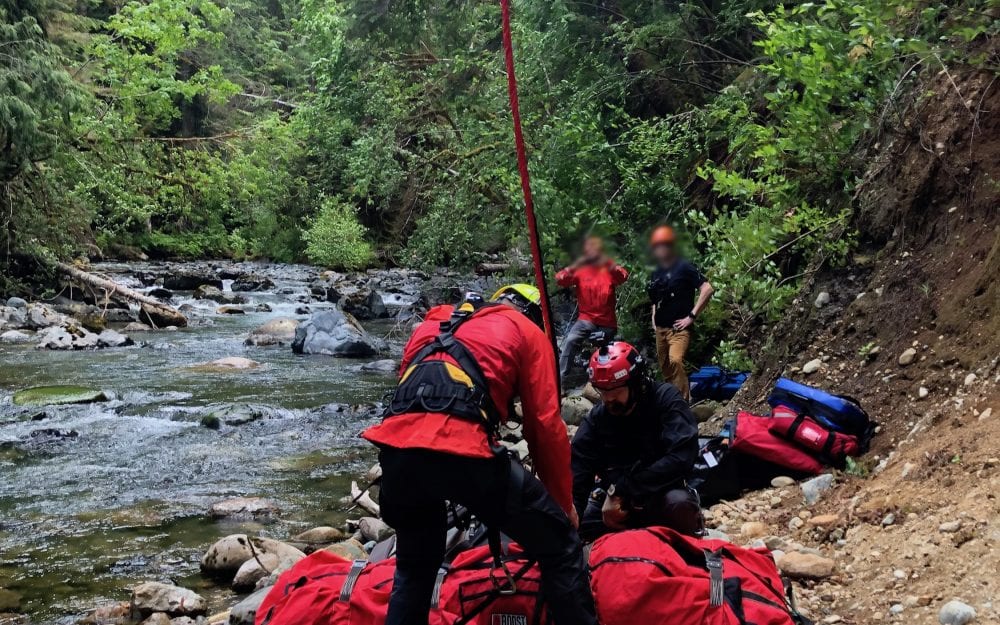The Chat
As we continue to transition between seasons on the mountains, the number and types of calls North Shore Rescue responds to change as well. Lengthening daylight hours, warm temperatures in the city, and the appearance of snowmelt on the visible parts of the North Shore Mountains tend to call people to the outdoors in droves. Frankly, this is an understandable phenomenon after a long rainy Vancouver winter. We have some pretty amazing places for summer hikers to visit, and some pretty amazing vistas to be had. That said, it is not summer on the mountains and to assume such can be a fatal mistake!
…it is not summer on the mountains…
However, just because the weather is changing to favour the cotton t-shirt over Gortex jackets, does not mean we get to be complacent in the mountains. Just the other day I went hiking up Mount Seymour and was astounded by both the sheer number of people up there and the proportion of those people leaving the parking lot wholly unprepared for the prevailing conditions. It would not be an understatement to say that pool of potential search and rescue customers was expansive. This is, unfortunately, pretty much standard every sunny day on the local mountains.
I want to state this clearly, the second you leave the parking lot, you can no longer rely on being able to call 911 and have a paramedic, police officer or firefighter at your side in moments. The mountains are dangerous, and they have taken many lives over the years both close to and far away from the parking lot. Stating this is not intended to discourage people from getting out there, but to highlight how important preparedness is in doing so. Although no amount of preparation can eliminate risk, it can significantly reduce it, and vastly increase your chances of avoiding becoming our customer…and even if you do end up needing our services, that same preparation can help to make sure we get you out alive.
In recent days I have been seeing an increase in the number of pictures being posted on social media showing mountain destinations during the summer months. This, unfortunately, is highly and unintentionally misleading. For instance, this photograph shows the popular destination of Saint Marks summit in what appear to be perfect conditions. The problem, the entire route to Saint Marks remains covered in snow. To compound this, rising temperatures mean that much of this snow is undercut creating the potential to fall through into deep crevices. Obviously attempting this trail in running shoes and a t-shirt would be a tremendous and potentially fatal error.
View this post on Instagram
This “Social Media Effect” has very real-world consequences in that it normalizes heading into the mountains like it is a simple trip to the local gym. In fact, last night NSR crews responded to a call on Dog Mountain for an unprepared, dehydrated, and exhausted lost hiker. This individual’s situation was the epitome of Murphy’s Law, everything that could go wrong did go wrong for her. In this case, the lost hiker was abandoned by her hiking group, she was wearing street shoes with light workout clothing only, and she immediately lost the trail trying to make the way out on her own. To her credit, she made the decision to call for rescue relatively early, allowing our members to find her with relative ease and safety.
That said, when our crews arrived on the scene, the subject was so unprepared, exhausted and dehydrated, there came a point in the hike out where it became necessary to piggyback the subject. This, of course, makes our rescue efforts more difficult in terms of the time it takes us away from our families and paying work, but also increases the risk of injury to our own members. The reality is that preparation also helps protect our crews if you do ultimately need our services (which we gladly provide in all circumstances).
To temper my Murphy’s Law reference, I will say that this subject got very lucky in a number of respects:
- She did not injure herself (as she could have succumbed to hypothermia);
- She was able to make a 911 call (as there is no telling when her absence would have been reported if there had been no cell coverage); and
- Rescue crews were able to get to her relatively quickly, which is not always the case.
This is not to single out a single rescue subject for ridicule but to highlight a teachable moment which is exemplified by these circumstances. Preparation is important, and this particular subject is one of a great majority of mountain users who head out unprepared every day. For instance, just two weeks ago our team responded to a call for 4 unprepared hikers on Mount Seymour which nearly resulted in a very sad outcome (see Global News Coverage). While originally departing for Dog Mountain, again prepared for a summer walk in a city park, the group ended up stranded in deep snow, above cliff bands, near the First Pump of Mount Seymour.
Alright, to recap, so far we have established that:
- there are a lot of people heading out unprepared under false impressions or naive of the risks;
- that your risk increases exponentially when you head out unprepared;
- that relying on social media portrayals of popular hiking destinations is dangerous;
- that being unprepared can increase the risk to rescue crews if you do ultimately need our help;
- that the mountains are responsible for many fatalities, and many near misses; and
- luckily that proper preparation and training can mitigate these risks substantially
So then, when you (or your family member/friend/colleague/acquaintance/neighbour/frenemy that you share this with) head out, how can you reduce your risk of becoming our customer, and/or dying?
1. Research the route and make a plan
Don’t rely on word of mouth or social media posts for your planning. Make sure you know the route, the weather, the risks, and what you need to take with you well before you get to the trailhead. This step can also help you determine if you are mentally and physically prepared for the undertaking. If you aren’t quite ready for what you want to do, it makes sense to pick easier routes while training and conditioning to get to the point where you can head out safely.
If you lack the equipment or are not prepared for a particular hike, DON’T DO IT. You can always seek help from a more experienced friend, join a hiking club, or head down to Mountain Equipment Co-op for advice. Likewise, if the conditions are not looking good, reschedule it.
Ultimately, the more time you spend on planning, the easier the actual hike will be in terms of navigation (it is important to stay on route and follow the trail), and if you do ultimately end up getting into trouble, a detailed plan left with someone responsible will make it a lot easier for us to find you.
Resources:
- Adventure Smart – https://www.adventuresmart.ca/trip-plan/
- Weather Office – https://weather.gc.ca/city/pages/bc-74_metric_e.html
- Province of BC Topographic Map Viewer – https://www2.gov.bc.ca/gov/content/data/geographic-data-services/topographic-data/topographic-map-viewer
- Trip Planning Resource Page – https://www.ashikaparsad.com/trip-planning-links/
- Club Tread Trip Reports – http://forums.clubtread.com/
2. Tell someone responsible where you are going
This one may not keep you from becoming a customer, but it will definitely increase your chances of being found alive if something goes wrong. Furthermore, it is free, quick and should be done every time you head into the mountains, no matter how mundane the trip. Many people have died on the North Shore Mountains because their absence went unreported and/or no one knew where they went.
You cannot count on cell phones or other electronics in the mountains, but you can always count on a reliable person who knows where you are going, and when to expect you back. Failing to do this simple task not only increases your chances of not making it out alive, but it also increases the risk to searchers who must spend more time on unfocused searching looking for you.
3. Wear appropriate clothing and footwear
This one should be self-explanatory but unfortunately seems to be one of the most common mistakes made every day on the local mountains. If you want to be a candidate for the Darwin awards, definitely wear a cotton t-shirt and flip-flops, sandals, or street shoes. If you would rather enjoy a nice hike in the woods where you get home safely, then this is definitely the right place to spend a little bit of cash.
Anything other than a hiking boot or trail runner, with a proper aggressive tread and ankle support, are not appropriate for the trails. Similarly, cotton or denim clothing is almost never appropriate beyond the parking lot. While sporting wear is fine, it is important to layer and have something warm to wear if you do become injured or stuck and cannot keep moving. It can get cold up there, even in the middle of summer.
Head down to your local outdoor store (ie. MEC) and get the right footwear, and the right clothing. The reality is that improper footwear, no matter your experience or other preparation, is a sure fire way to end up as a North Shore Rescue customer.
4. Take the 10 Essentials
This is another one that will both decrease your chances of getting to hang out with me or my colleagues, or you know, not making it back at all. Quite frankly, you should have a small backpack no matter how simple the hike, and in this backpack, you should have the following:
- Flashlight
- Fire making kit
- Signalling device (i.e. whistle)
- Extra food and water
- Extra clothing (Warm Clothing)
- Navigational/communication devices (GPS, Map & Compass, Satellite Communications Device, Cell Phone)
- First aid kit
- Emergency blanket/shelter
- Pocket knife
- Sun protection
You do not need to break the bank to kit yourself out with most of the above. Just like a skier has to have skis and boots to hit the slopes, you need some variant of this gear to hit the trails.
Do not plan for the best case scenario, plan for the worst case (ie. a broken ankle out of cellphone range). You would be shocked how many calls NSR responds to for stranded hikers who are lost because they don’t have a flashlight… This one personally drives me absolutely nuts. PS your cellphone is not a sufficient flashlight!
Head to our 10 Essentials Page or the Adventure Smart website for more information on what you should be taking with you when you head into the woods.
5. Travel in a group and stay together
Travelling alone in the mountains is generally a bad idea, with some rare exceptions. If you fall or have a medical emergency, if you are by yourself there is a good chance no one will be able to assist you. Similarly, it is nice to be able to share the load and to be able to discuss route finding with someone.
When you do travel in a group, you should travel at the speed of the slowest group member, and you should only split up in the rarest of circumstances. This is a common mistake we see where the faster more experienced member of the group “takes off”, and the slower member suffers a medical emergency or becomes lost. Please communicate with your group, and set realistic goals!
6. If you aren’t prepared, turn around early!
This one should be self-explanatory, but clearly, it isn’t. If at any time, including at the parking lot, it becomes clear that you are unprepared for the conditions, TURN AROUND! This is a critical part of risk management that seems to be forgotten quite often. Things change from the planning stage, and those changes should be taken into account when deciding to move forward. There are always easier, safer options to fall back upon. So if you find yourself in sneakers on a snowy trail, slipping and falling, getting further and further from the parking lot, this is the time to check yourself and save yourself some pain and embarrassment.
Remember, there is no prize for pushing on in the face of dangerous conditions and unpreparedness…except for maybe a Darwin Award.
No Charge for Rescue
North Shore Rescue strictly does not support fines or charging victims for rescue services. Inevitably, any time we or the media highlight mistakes made by those we rescue we see a slew of uninformed calls to punish and take retribution on the unlucky victim. We do not highlight these mistakes to feed this rage, we do it in the hopes that even one person reads about someone else’s folly, and makes a good decision that keeps them out of trouble. We truly believe that outdoor pursuits have a strong positive benefit to society, and our intent is not to discourage people from getting out there. We wouldn’t volunteer to do this if we didn’t think it was worthwhile. What we do want to do is to help people do it safely and in a way that reduces the amount of time we have to spend away from our families, our paying jobs, and our own pursuits.
With that in mind, please read this post objectively, internalize the lessons, and pass them on where you can. Education is the keystone to Search and Rescue prevention, not punishment or deterrence. The latter approaches although satisfying our carnal need to take a pound of flesh from wrongdoers, in reality only lead to delays which increase the risk to the victims and the rescuers, with no discernable offset of the already minimal cost to the taxpayer.
In other words, put away the pitch forks and help us spread the safety messaging.



